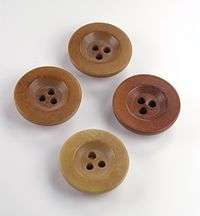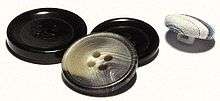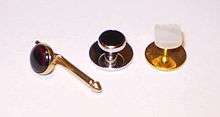Button


In modern clothing and fashion design, a button is a small fastener, now most commonly made of plastic, but also frequently of metal, wood or seashell, which secures two pieces of fabric together. In archaeology, a button can be a significant artifact. In the applied arts and in craft, a button can be an example of folk art, studio craft, or even a miniature work of art.
Buttons are most often attached to articles of clothing but can also be used on containers such as wallets and bags. However, buttons may be sewn onto garments and similar items exclusively for purposes of ornamentation. Buttons serving as fasteners work by slipping through a fabric or thread loop, or by sliding through a buttonhole. Other types of fastenings include zippers, Velcro and magnets.
History
Buttons and button-like objects used as ornaments or seals rather than fasteners have been discovered in the Indus Valley Civilization during its Kot Yaman phase (c. 2800–2600 BCE)[1] as well as Bronze Age sites in China (c. 2000–1500 BCE), and Ancient Rome.
Buttons made from seashell were used in the Indus Valley Civilization for ornamental purposes by 2000 BCE.[2] Some buttons were carved into geometric shapes and had holes pierced into them so that they could be attached to clothing with thread.[2] Ian McNeil (1990) holds that: "The button, in fact, was originally used more as an ornament than as a fastening, the earliest known being found at Mohenjo-daro in the Indus Valley. It is made of a curved shell and about 5000 years old."[3]
Functional buttons with buttonholes for fastening or closing clothes appeared first in Germany in the 13th century.[4] They soon became widespread with the rise of snug-fitting garments in 13th- and 14th-century Europe.
Buttons as containers
Since at least the seventeenth century, when box-like metal buttons were constructed especially for the purpose,[5] buttons have been one of the items in which drug smugglers have attempted to hide and transport illegal substances. At least one modern smuggler has tried to use this method.[6]
Also making use of the storage possibilities of metal buttons, during the World Wars, British and U.S. military locket buttons were made, containing miniature working compasses.[7]
Materials and manufacture
Because buttons have been manufactured from almost every possible material, both natural and synthetic, and combinations of both, the history of the material composition of buttons reflects the timeline of materials technology.
Buttons can be individually crafted by artisans, craftspeople or artists from raw materials or found objects (for example fossils), or a combination of both. Alternatively, they can be the product of low-tech cottage industry or can be mass-produced in high-tech factories. Buttons made by artists are art objects, known to button collectors as "studio buttons" (or simply "studios", from studio craft).[8]
Nowadays, hard plastic, seashell, metals, and wood are the most common materials used in button-making; the others tending to be used only in premium or antique apparel, or found in collections.
Over 60% of the world's button supply comes from Qiaotou, Yongjia County, China.[9][10]
Decoration and coating techniques
Historically, fashions in buttons have also reflected trends in applied aesthetics and the applied visual arts, with buttonmakers using techniques from jewellery making, ceramics, sculpture, painting, printmaking, metalworking, weaving and others. The following are just a few of the construction and decoration techniques that have been used in button-making:
Styles of attachment



- Shank buttons have a hollow protrusion on the back through which thread is sewn to attach the button.[18] Button shanks may be made from a separate piece of the same or a different substance as the button itself, and added to the back of the button, or be carved or moulded directly onto the back of the button, in which latter case the button is referred to by collectors as having a 'self-shank'.
- Flat or sew-through buttons have holes through which thread is sewn to attach the button.[19] Flat buttons may be attached by sewing machine rather than by hand, and may be used with heavy fabrics by working a thread shank to extend the height of the button above the fabric.
- Stud buttons (also push-through buttons or just studs) are composed from an actual button, connected to a second, button-like element by a narrow metal or plastic bar - pushed through two opposing holes within what is meant to be kept together, the actual button and its counterpart press it together, keeping it joined. Popular examples of such buttons are shirt studs and cufflinks.
- Snap fasteners (also pressure buttons or press studs) are metal (usually brass) round discs pinched through the fabric. They are often found on clothing, in particular on denim pieces such as pants and jackets. They are more securely fastened to the material. As they rely on a metal rivet attached securely to the fabric, pressure buttons are difficult to remove without compromising the fabric's integrity. They are made of two couples: the male stud couple and the female stud couple. Each couple has one front (or top) and rear (or bottom) side (the fabric goes in the middle).
Fabric buttons
- Covered buttons are fabric-covered forms with a separate back piece that secures the fabric over the knob.
- Mandarin buttons or frogs are knobs made of intricately knotted strings. Mandarin buttons are a key element in Mandarin dress (Qi Pao and cheongsam in Chinese), where they are closed with loops. Pairs of mandarin buttons worn as cuff links are called silk knots.
- Worked or cloth buttons are created by embroidering or crocheting tight stitches (usually with linen thread) over a knob or ring called a form. Dorset buttons, handmade from the 17th century to 1750, are of this type.
Button sizes
The size of the button depends on its use. Shirt buttons are generally small, and spaced close together, whereas coat buttons are larger and spaced further apart. Buttons are commonly measured in lignes (also called lines and abbreviated L), with 40 lignes equal to 1 inch. For example, some standard sizes of buttons are 16 lignes (10.16 mm, standard button of men's shirts) and 32 lignes (20.32 mm, typical button on suit jackets).
The American National Button Society (NBS)[20] has its own button sizing system which divides button sizes into 'small', 'medium' and 'large'.
Buttons in museums and galleries
Some museums and art galleries hold culturally, historically, politically, and/or artistically significant buttons in their collections. The Victoria & Albert Museum has many buttons,[21] particularly in its jewellery collection, as does the Smithsonian Institution.[22][23][24][25]
Hammond Turner & Sons, a button-making company in Birmingham, hosts an online museum with an image gallery and historical button-related articles,[26] including an 1852 article on button-making by Charles Dickens.[27] In the USA, large button collections are on public display at the Waterbury Button Museum] of Waterbury, Connecticut,[28] the Keep Homestead Museum of Monson, Massachusetts,[29] which also hosts an extensive button archive,[30] and in Gurnee, Illinois at The Button Room.[31]
Gallery
|
Buttons in politics
The mainly American tradition of politically significant clothing buttons appears to have begun with the first presidential inauguration of George Washington in 1789. Known to collectors as "Washington Inaugurals",[32] they were made of copper, brass or Sheffield plate, in large sizes for coats and smaller sizes for breeches.[33] Made in twenty-two patterns and hand-stamped, they are now extremely valuable cultural artifacts.
Between about 1840 and 1916, clothing buttons were used in American political campaigns, and still exist in collections today. Initially, these buttons were predominantly made of brass (though horn and rubber buttons with stamped or moulded designs also exist) and had loop shanks. Around 1860 the badge or pin-back style of construction, which replaced the shanks with long pins, probably for use on lapels and ties, began to appear.[34]
One common practice that survived until recent times on campaign buttons and badges was to include the image of George Washington with that of the candidate in question.
Some of the most famous campaign buttons are those made for Abraham Lincoln. Memorial buttons commemorating Lincoln's inaugurations and other life events, including his birth and death, were also made, and are also considered highly collectible.[35]
See also
References
- ↑ Khan, Omar (1999). "Fired steatite button". The Indus Civilization. San Francisco, USA: harrapa.com. Retrieved 11 March 2010.
- 1 2 Hesse, Rayner W. & Hesse (Jr.), Rayner W. (2007). Jewelrymaking Through History: An Encyclopedia. Greenwood Publishing Group. 35. ISBN 0-313-33507-9.
- ↑ McNeil, Ian (1990). An encyclopaedia of the history of technology. Taylor & Francis. 852. ISBN 0-415-01306-2.
- ↑ Lynn White: "The Act of Invention: Causes, Contexts, Continuities and Consequences", Technology and Culture, Vol. 3, No. 4 (Autumn, 1962), pp. 486–500 (497f. & 500)
- ↑ (Luscomb 2003, p. 126)
- ↑ "A look at China's "Button Town", by Seth Doane, CBS News
- ↑ "Chinese 'Button Town' Struggles with Success", by Louisa Lim, NPR
- ↑ (Luscomb 2003, p. 53)
- ↑ (Luscomb 2003, p. 104)
- ↑ (Luscomb 2003, pp. 123–124)
- ↑ Button Country (2010). "Back Types/Shanks (23-3)". GA, USA: Peach State Button Club. Retrieved 11 March 2010.
- ↑ Colton, Virginia, ed. (1978). Complete Guide to Sewing. Reader's Digest. p. 352. ISBN 0-89577-026-1.
- ↑ "Home". Nationalbuttonsociety.org. Retrieved 2011-12-25.
- ↑ buttons
- ↑ American Indian Buttons made with ivory, whalebone and ink at the Smithsonian National Museum of the American Indian.
- ↑ Domestic button collection, circa 1935, from Washington, D.C., at the Smithsonian National Museum of American History.
- ↑ Uniform buttons of the United States Postal Service at 'Arago', the Smithsonian National Postal Museum.
- ↑ Silver buttons held in the Smithsonian American Art Museum's Renwick Gallery
- ↑ Hammond Turner & Sons
- ↑ Dickens article
- ↑ The Waterbury Button Museum
- ↑ Keep Homestead Museum
- ↑ online button archive
- ↑ The Button Room
- ↑ Cobb, J. Harold; Kirk Mitchell (Feb 2, 2005). "J. Harold Cobb's George Washington Inaugural Button Collection". J. Harold Cobb's George Washington Inaugural Button Collection. USA: Kirk Mitchell. Retrieved 13 March 2010.
- ↑ (Luscomb 2003, pp. 214–218)
- ↑ (Luscomb 2003, pp. 33–34)
- ↑ (Luscomb 2003, pp. 119–120)
Bibliography
- Bunch, Bryan (2004). The History of Science and Technology. Boston, MA: Houghton Mifflin. p. 784. ISBN 978-0-618-22123-3.
- Edwards, Nina (2012) (2012). On the Button: The Significance of an Ordinary Item. London, UK: I. B. Tauris. ISBN 978-1-84885-584-7.
- Kohler, Carl (1963). A History of Costume. USA: Dover. p. 464. ISBN 978-0-486-21030-8.
- Luscomb, Sally C. (2003). The Collector's Encyclopedia of Buttons (5th ed.). Atglen, PA: Schiffer. ISBN 0-7643-1815-2.
- Osborne, Peggy A. (1997). Button, button : identification and price guide. Atglen, PA: Schiffer. p. 167. ISBN 0-7643-0082-2.
- Peacock, Primrose (1978). Discovering old buttons. Discovering series ; no. 213. Rosemary Godsell (illus.). Aylesbury, UK: Shire Publications. p. 76. ISBN 0-85263-445-5.
- Wisniewski, Debra J. (1997). Antique & collectible buttons : identification & values. Charley Lynch. Paducah, KY: Collector Books. p. 168. ISBN 0-89145-711-9.
External links
| Wikimedia Commons has media related to Buttons (clothing). |
- Button-making in Birmingham, England in the 1800s
- Scans of original 1830–1940 US patents for buttons & related tools & machinery
- Online collection of historical buttons at the Button Museum



